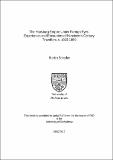The Habsburg Empire under foreign eyes : experiences and encounters of nineteenth-century travellers, c. 1815-1869
View/
Date
2017Author
Supervisor
Funder
Metadata
Show full item recordAltmetrics Handle Statistics
Abstract
In his seminal 1994 study ‘Inventing Eastern Europe’, Larry Wolff argued that Eastern Europe was created in the Enlightenment era and conceptualised along a dividing line stretching from Szczecin at the Baltic to Trieste at the Adriatic. This line would have divided the Habsburg Empire in eastern and western halves. This thesis asks how British and German travellers perceived the Habsburg Empire in the period between 1815 and 1869, when, according to Wolff, the division must have already been established.
By analysing published travelogues it is possible to gain a better understanding of where these travellers located ‘western’ and ‘Eastern Europe’ but also to examine the existence of other spatial concepts such as ‘northern’ and ‘Southern Europe’. Methodologically, this study ties together the concepts of transnational history since the travellers under examination ventured abroad, and comparative history due to the focus on two distinct groups, as well as spatial history in the form of mental maths.
The thesis argues that based on the analysis of travelogues it seems that there was no coherent view on the Habsburg Empire as being situated in ‘eastern Europe. Rather, the travellers seemed to have applied a ‘fragmented view’, singling out and assessing various regions of the Empire differently. Yet, for most travellers from ‘East’ was not found within the Habsburg Empire but rather beyond its frontiers, particularly emphasised by those who engaged with the concept of Germany. Based on these results, the thesis argues that instead of assuming that the division of Europe changed from ‘North-South to East-West, we should regard both spatial discourses in parallel, but with varying intensity.
Type
Thesis, PhD Doctor of Philosophy
Collections
Items in the St Andrews Research Repository are protected by copyright, with all rights reserved, unless otherwise indicated.

